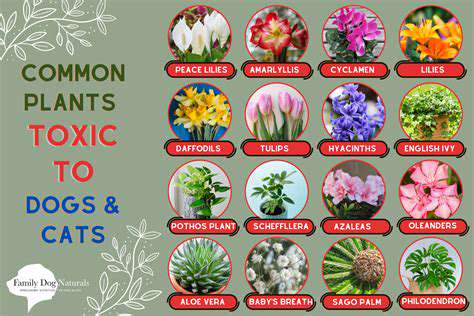Pet Friendly Gardening: Safe Plants and What to Avoid
- Amaryllis (bulbs are most toxic)
- Daffodils (especially the bulbs)
- Sago palms (all parts are poisonous)
When in doubt about a plant's safety, it's better to err on the side of caution and keep it away from pets. Many veterinary clinics provide lists of toxic plants specific to your region.
How to Examine Plants Carefully
Proper identification involves looking at multiple plant characteristics:
- Leaf shape and arrangement
- Flower color and structure
- Stem texture and growth pattern
- Berry or seed pod appearance
Never rely on just one feature when identifying plants - some toxic species closely resemble safe ones. Always cross-check with reliable sources like botanical guides or your local extension service.
Where Plants Grow Matters
A plant's location affects its risk level. Those growing near pet play areas or along walking paths pose greater danger. Consider these factors:
- Plants in containers pets can knock over
- Vines growing where pets might chew them
- Fallen leaves or berries in pet areas
Soil conditions can also influence toxicity. Some plants absorb more heavy metals or other contaminants in certain environments, making them more dangerous.
Keeping Pets Safe from Harmful Plants
Prevention is always better than treatment when it comes to plant toxicity. Effective strategies include:
- Creating physical barriers around toxic plants
- Training pets to avoid certain garden areas
- Providing pet-safe chewing alternatives
Supervision is key - never assume a pet will naturally avoid dangerous plants. Many animals explore the world with their mouths, especially when young.
Removing Hazardous Plants Properly
When removing toxic plants, follow these guidelines:
- Wear gloves to protect yourself
- Dig up the entire root system
- Dispose of plants in sealed bags
- Never compost toxic material
Check local regulations for disposing of invasive or particularly dangerous species. Some communities have special collection programs.
When to Get Expert Help
If you suspect your pet has eaten a toxic plant:
- Note the time of ingestion
- Identify the plant if possible
- Call your vet or pet poison hotline immediately
Keep emergency numbers handy and know the location of the nearest 24-hour veterinary clinic. Quick action can make all the difference in serious cases.

Safe and Pet-Friendly Alternatives
Natural Ways to Control Pests
Instead of chemical pesticides, try these pet-safe methods:
- Plant marigolds to deter nematodes
- Use diatomaceous earth for crawling insects
- Introduce beneficial insects like ladybugs
These approaches protect both your pets and the environment while effectively managing pests.
Beautiful Yet Safe Flowers
Many colorful blooms pose no threat to pets:
- African violets
- Snapdragons
- Petunias
These provide vibrant color without the worry. Always research specific varieties as some cultivars may differ in toxicity.
Foliage That's Safe for Pets
Consider these attractive leaf plants:
- Spider plants
- Boston ferns
- Peperomia
These add texture and interest while being non-toxic if nibbled.
Pet-Safe Ground Covers
Great options include:
- Irish moss
- Baby's tears
- Creeping thyme
These create lush carpets that stand up to light pet traffic.
Selecting the Right Plants
When choosing plants:
- Verify safety with multiple sources
- Consider your pet's habits
- Plan for plant placement
The ASPCA maintains a comprehensive list of toxic and non-toxic plants that's regularly updated.
Creating a Pet-Safe Garden
Smart Plant Selection
Key considerations when choosing plants:
- Avoid plants with berries or seed pods that might attract pets
- Select sturdy plants that can withstand some pet attention
- Include some pet-friendly grasses for nibbling
Think about your pet's personality - curious chewers need extra precautions.
Designing a Secure Space
Physical barriers work best:
- Raised beds for delicate plants
- Decorative fencing around garden areas
- Designated pet zones with safe plants
Create clear boundaries while maintaining an attractive landscape.
Maintaining a Healthy Garden
Regular care tips:
- Remove fallen leaves promptly
- Check for pest problems early
- Use organic fertilizers
- Keep water features clean
Consistent maintenance prevents many problems before they start.
Training Pets to Respect the Garden
Teaching boundaries:
- Establish clear no zones
- Reward good behavior
- Provide alternative digging areas
With patience, most pets can learn to coexist safely with gardens.
Emergency Preparedness
Be ready for accidents:
- Keep pet first aid supplies
- Post emergency numbers visibly
- Know basic pet CPR
Preparation helps you respond quickly if problems occur.